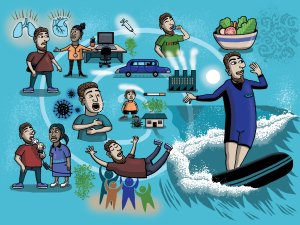Respiratory physician Lutz Beckert considers chronic obstructive pulmonary disease management, including the prevention of COPD, the importance of smoking cessation and pulmonary rehabilitation, and the lifesaving potential of addressing treatable traits. He also discusses the logic of inhaler therapy, moving from single therapy to dual and triple therapy when indicated, as well as other aspects of management
Aotearoa’s government-funded school lunches failing nutrition standards
Aotearoa’s government-funded school lunches failing nutrition standards

The School Lunch Collective (SLC), the major provider supplying 51% of students in Ka Ora, Ka Ako | Healthy School Lunches Programme, has been hitting the headlines for poor quality, meal mislabelling, inappropriate special dietary meals, missed deliveries, and overheated meals. However, one aspect that is getting less airtime is nutritional quality.
We assessed the lunches provided by SLC against National Nutrient Reference Values, international benchmarks for energy, and the Ministry of Education’s Nutrition Standards for Ka Ora, Ka Ako. The SLC lunches only provided about half the energy expected for a school lunch and less than a fifth of the daily energy requirements for growing teens. Despite all providers being contractually obliged to meet the Ministry of Education’s Nutrition Standards, none of the 13 meals offered by the SLC met them. (Only 13 out of 53 SLC meals had sufficient information to assess them.) Along with the other well-published shortcomings, the nutritional value of the lunches provided by the SLC needs to be closely scrutinised.
The 2025 model for Ka Ora, Ka Ako | Healthy School Lunches Programme1 was radically changed to save costs, moving from a model consisting of local suppliers to a large national consortium for the majority of Years 7+ learners on the programme.2 The consortium, the School Lunch Collective (SLC),3 now delivers lunches to more than half of the students on the programme.2 We assessed the lunches provided by SLC against National Nutrient Reference Values,4 international benchmarks5 for energy and the Ministry of Education’s Nutrition Standards for Ka Ora, Ka Ako.6
In October 2024, Cabinet announced major budget cuts to Ka Ora, Ka Ako with the funding for Years 7-13 lunches reduced from $6.99 (Years 4-8) and $8.90 (Years 9+) to $3.2 Schools could continue to use internal model providers (where the meals are made at the school or by a local school on the programme) or remain on the iwi/hapu model if the providers could supply the meals at a reduced price of $4. Lunches remained at status quo for schools with Years 0-6 students. The School Lunch Collective,3 a consortium formed at the time between Compass Group NZ, Gilmours and Libelle Group, were contracted to take over lunch supply to the remaining 124,941 students on the programme.7
The Ministry of Education Nutrition Standards for Ka Ora, Ka Ako | Healthy School Lunches Programme,6 stipulates minimum cooked weights for the total meal and each compulsory meal component (grams of vegetables, grams of protein foods, grams of grain foods and starchy vegetables). The minimum weight requirements differ for years 0-3, 4-8 and 9+. All SLC meals are now a minimum of 240g, which meets the minimum weight for years 0-8. To bring the weight up to the minimum of 300g for years 9+, two snacks are provided alongside the main meal. The service agreement with SLC outlines monthly review to assess service delivery performance against key metrics, which includes nutrition.7
The SLC has published only limited nutrition information for each meal and snack (energy, protein, fat, carbohydrate, sugars, and sodium per 100g and per meal) on their website. The information on ingredients was insufficient for many of the meals to be assessed against the Nutrition Standards (see Appendix). The full recipes have not been publicly released by the Ministry of Education or the SLC. Incomplete information regarding the quantity of ingredients included in recipes meant we were only able to assess at least one of the compulsory meal components in the Nutrition Standards for 13 of the 53 meals (with snacks considered for years 9+).
None of the meals met all the Nutrition Standards for all age groups.
An Official Information Act reply from the Ministry of Education, when referring to the SLC meals, states “the new contract requires that meals meet the Nutrition Standards developed for the programme in 2022. Every lunch provided by meal providers is to meet the nutritional standards.”
The Nutrition Standards are ‘food-based’ so unlike other international school lunch programmes there are no minimum energy (kJ) standards for the lunches, however, it is expected that a lunch (including the snacks) should provide about 30% of the energy a student needs for the day, in line with school lunch programmes in other high-income countries.5 We have compared the energy of SLC meals to National Nutrient Reference Values4 and Ka Ora, Ka Ako meals analysed in the 2022 nutrition evaluation conducted by the Ministry of Education5 (see Table 1). Energy provided by the SLC meals is well below 30% of daily energy requirements and much lower than the Ka Ora, Ka Ako meals analysed in the 2022 evaluation.5 The meals for years 4-8 provide less than 15% of daily energy requirements and the meals for years 0-3 and 9+ provide less than 18%. Despite acknowledging the low energy of the meals in the 2022 evaluation,5 there has been a marked decrease in energy provision for all year groups instead of an improvement.
| Year group (age) | Recommended energy for lunch* | Median energy SLC meal (n = 53) |
% energy of meal of daily requirement** | Median energy 2022 meal (n = 302) |
% energy of meal of daily requirement** |
|---|---|---|---|---|---|
| Years 0-3 (age approx. 5-8) | |||||
| Boys | 1860-2100 kJ | 1083 kJ | 16.4% | 1522 kJ | 23.1% |
| Girls | 1710-1950 kJ | 1083 kJ | 17.8% | 1522 kJ | 25.0% |
| Years 4-8 (age approx. 9-12) | |||||
| Boys | 2190-2790 kJ | 1083 kJ | 13.0% | 1772 kJ | 21.3% |
| Girls | 2070-2550 kJ | 1083 kJ | 14.1% | 1772 kJ | 23.0% |
| Years 9+ (age approx. 13-18) | |||||
| Boys | 3000-3750 kJ | 1637 kJ *** | 14.6% | 2332 kJ | 20.7% |
| Girls | 2670-2910 kJ | 1637 kJ *** | 17.6% | 2332 kJ | 25.1% |
*Based on a child with a Physical Activity Level (PAL) of 1.6 - ‘light activity4
**Calculated as the midpoint of the range of energy requirements within the age group4
***Includes 2 snacks
The SLC has failed to fully disclose sufficient information to assess compliance of all meals despite their website stating, ‘transparency is at the heart of what we do’. As a taxpayer-funded programme, we believe there should be sufficient published information on the ingredients to determine if the lunches meet the Ka Ora Ka Ako Nutrition Standards. From the meals published with sufficient information, our analysis shows a lack of compliance.
Given that 27% of children in New Zealand live in households where food runs out often or sometimes,8 the very low energy content of the meals is especially worrying. The energy provided is 30-40% lower than the lunches served in 2022 under the original funding model and only around half the energy (kilojoules) recommended for lunches for children.
We found that the meals are very low in energy, providing approximately half of the energy expected for a school lunch and 30-40% less than lunches provided under the previous model.
Of the 13 meals that could be analysed against at least one of the Nutrition Standards, none met all standards for all age groups.
Based on available information, the SLC is delivering substandard lunches to children, which is a major breach of their contractual requirements.
There is a lack of transparency in the content of many of the meals. We call for the energy and ingredient information for all meals to be provided with the inclusion of a percentage contribution of each ingredient to the total meal weight (based on cooked weights).
The meals should be reviewed by the supplier and qualified nutritionists/dietitians to ensure they meet the Nutrition Standards for each of the year groups supplied.
The energy content of all meals is inadequate and should be increased.
Compliance with meeting Nutrition Standards should be part of an urgent full review of compliance across all contractual obligations.
The SLC has published the nutrition information for each meal and snack (energy, protein, fat, carbohydrate, sugars, and sodium, per 100g and per meal) on their website. A list of ingredients is also provided. For some meals, the ingredient information provided aligns with the Food Standards Code9 for packaged foods with the ingredients listed in descending order. Some items also have the percentage of an ingredient (e.g. beef 19%, onion 2.3%) while others list only the main ingredients (e.g. Mexican beans (kidney beans, black beans, white beans) with vegetables, rice) – this makes it impossible to determine if they meet the Nutrition Standards for minimum amounts of the compulsory components in grams. The full recipes have not been publicly released by the Ministry of Education or the SLC.
- Ministry of Education. 2025. Ka Ora, Ka Ako Healthy School Lunches Programme. https://kaorakaako.education.govt.nz/
- Ministry of Education. 2025. Supplier – Termly Pānui https://kaorakaako.education.govt.nz/working-together/programme-updates/supplier-termly-panui
- School Lunch Collective. 2025 https://www.schoollunchcollective.co.nz/
- NHMRC. Nutrient Reference Values: Dietary Energy https://www.eatforhealth.gov.au/nutrient-reference-values/nutrients/dietary-energy
- De Seymour J, Stollenwerk Cavallaro A, Wharemate-Keung L, Ching S, Jackson J. Nutrient-level evaluation of meals provided on the government-funded school lunch program in New Zealand. Nutrients. 2022; 14(23):5087. https://doi.org/10.3390/nu14235087
- Ministry of Education. 2025. Nutrition Standards for Ka Ora , Ka Ako menus https://kaorakaako.education.govt.nz/nutrition-standards
- Ministry of Education. Services Agreement. 2024. Ka Ora, Ka Ako / Healthy School Lunches Programme – Integrated Supply Solution https://web-assets.education.govt.nz/s3fs-public/2025-02/1341081%20OIA%20-%20Appendix%20A.pdf
- Ministry of Health. 2025. New Zealand Health Survey 2023/24 Annual Data Explorer. minhealthnz.shinyapps.io/nz-health-survey-2023-24-annual-data-explorer/_w_6c94bc04/#!/explore-indicators
- Food Standards Australia New Zealand. 2021 Standard 1.2.4 Information requirements – statement of ingredients. https://www.legislation.gov.au/F2015L00392/latest/text




![Barbara Fountain, editor of New Zealand Doctor Rata Aotearoa, and Paul Hutchison, GP and senior medical clinician at Tāmaki Health [Image: Simon Maude]](/sites/default/files/styles/thumbnail_cropped_100/public/2025-03/Barbara%20Fountain%2C%20editor%20of%20New%20Zealand%20Doctor%20Rata%20Aotearoa%2C%20and%20Paul%20Hutchison%2C%20GP%20and%20senior%20medical%20clinician%20at%20T%C4%81maki%20Health%20CR%20Simon%20Maude.jpg?itok=-HbQ1EYA)
![Lori Peters, NP and advanced health improvement practitioner at Mahitahi Hauora, and Jasper Nacilla, NP at The Terrace Medical Centre in Wellington [Image: Simon Maude]](/sites/default/files/styles/thumbnail_cropped_100/public/2025-03/2.%20Lori%20Peters%2C%20NP%20and%20advanced%20HIP%20at%20Mahitahi%20Hauora%2C%20and%20Jasper%20Nacilla%2C%20NP%20at%20The%20Terrace%20Medical%20Centre%20in%20Wellington%20CR%20Simon%20Maude.jpg?itok=sUfbsSF1)
![Ministry of Social Development health and disability coordinator Liz Williams, regional health advisors Mary Mojel and Larah Takarangi, and health and disability coordinators Rebecca Staunton and Myint Than Htut [Image: Simon Maude]](/sites/default/files/styles/thumbnail_cropped_100/public/2025-03/3.%20Ministry%20of%20Social%20Development%27s%20Liz%20Williams%2C%20Mary%20Mojel%2C%20Larah%20Takarangi%2C%20Rebecca%20Staunton%20and%20Myint%20Than%20Htut%20CR%20Simon%20Maude.jpg?itok=9ceOujzC)
![Locum GP Helen Fisher, with Te Kuiti Medical Centre NP Bridget Woodney [Image: Simon Maude]](/sites/default/files/styles/thumbnail_cropped_100/public/2025-03/4.%20Locum%20GP%20Helen%20Fisher%2C%20with%20Te%20Kuiti%20Medical%20Centre%20NP%20Bridget%20Woodney%20CR%20Simon%20Maude.jpg?itok=TJeODetm)
![Ruby Faulkner, GPEP2, with David Small, GPEP3 from The Doctors Greenmeadows in Napier [Image: Simon Maude]](/sites/default/files/styles/thumbnail_cropped_100/public/2025-03/5.%20Ruby%20Faulkner%2C%20GPEP2%2C%20with%20David%20Small%2C%20GPEP3%20from%20The%20Doctors%20Greenmeadows%20in%20Napier%20CR%20Simon%20Maude.jpg?itok=B0u4wsIs)
![Rochelle Langton and Libby Thomas, marketing advisors at the Medical Protection Society [Image: Simon Maude]](/sites/default/files/styles/thumbnail_cropped_100/public/2025-03/6.%20Rochelle%20Langton%20and%20Libby%20Thomas%2C%20marketing%20advisors%20at%20the%20Medical%20Protection%20Society%20CR%20Simon%20Maude.jpg?itok=r52_Cf74)
![Specialist GP Lucy Gibberd, medical advisor at MPS, and Zara Bolam, urgent-care specialist at The Nest Health Centre in Inglewood [Image: Simon Maude]](/sites/default/files/styles/thumbnail_cropped_100/public/2025-03/7.%20Specialist%20GP%20Lucy%20Gibberd%2C%20medical%20advisor%20at%20MPS%2C%20and%20Zara%20Bolam%2C%20urgent-care%20specialist%20at%20The%20Nest%20Health%20Centre%20in%20Inglewood%20CR%20Simon%20Maude.jpg?itok=z8eVoBU3)
![Olivia Blackmore and Trudee Sharp, NPs at Gore Health Centre, and Gaylene Hastie, NP at Queenstown Medical Centre [Image: Simon Maude]](/sites/default/files/styles/thumbnail_cropped_100/public/2025-03/8.%20Olivia%20Blackmore%20and%20Trudee%20Sharp%2C%20NPs%20at%20Gore%20Health%20Centre%2C%20and%20Gaylene%20Hastie%2C%20NP%20at%20Queenstown%20Medical%20Centre%20CR%20Simon%20Maude.jpg?itok=Z6u9d0XH)
![Mary Toloa, specialist GP at Porirua and Union Community Health Service in Wellington, Mara Coler, clinical pharmacist at Tū Ora Compass Health, and Bhavna Mistry, specialist GP at Porirua and Union Community Health Service [Image: Simon Maude]](/sites/default/files/styles/thumbnail_cropped_100/public/2025-03/9.%20Mary%20Toloa%2C%20Porirua%20and%20Union%20Community%20Health%20Service%20in%20Wellington%2C%20Mara%20Coler%2C%20T%C5%AB%20Ora%20Compass%20Health%2C%20and%20Bhavna%20Mistry%2C%20PUCHS%20CR%20Simon%20Maude.jpg?itok=kpChr0cc)